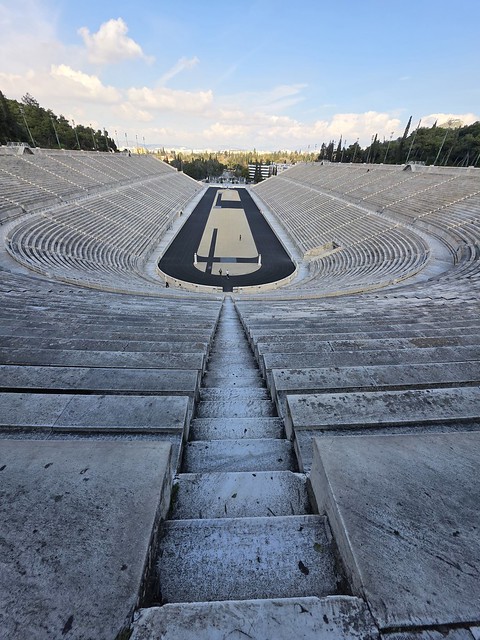Athens – Panathenaic Stadium (Part 2 – The Current Stadium)
This is the impressive current stadium, built on the same site as the original Panathenaic Stadium.
The stadium’s reconstruction was a significant undertaking, spearheaded by the Greek government and funded by the rather generous donation of Georgios Averoff, a wealthy Greek businessman who was based in Egypt. Times have changed somewhat from this era when men such as Averoff and the great Andrew Carnegie generously gave money to improve culture, literature and education. Today, we have Elon Musk, although I mustn’t drift too far into politics. The architect Anastasios Metaxas meticulously planned the reconstruction, drawing inspiration from the stadium’s ancient design. The stadium was rebuilt entirely with white marble from Mount Penteli, the same material used to construct the Acropolis. Having now experienced the stadium myself, this marble might not be the softest thing to sit on, but at least it stayed cool in what is often a hot general environment. This ambitious project was nearly completed in time for the 1896 Games, making the Panathenaic Stadium the only major stadium in the world built entirely of marble, with the unfinished bits sorted out not much later.
Despite being very brave, I do have a fear of heights and I wondered for a while if I would make it up to the top. However, after watching Richard positively sprinting up, I knew that I’d be able to manage it one way or another.
On 6 April 1896, the Panathenaic Stadium witnessed a historic moment as it hosted the opening ceremony of the first modern Olympic Games. The stadium was adorned with Greek and Olympic flags, creating a rather vibrant and festive atmosphere. King George I of Greece and his family were among the estimated 60,000 spectators, along with athletes from 14 nations, a sizeable arrangement for the time. The Games were officially opened by Crown Prince Constantine, marking the revival of this ancient tradition although I can’t imagine that they could have foreseen how big the games would become. The Panathenaic Stadium served as the venue for four of the nine sports that were contested at the 1896 Olympics, namely athletics, gymnastics, weightlifting and wrestling.
Perhaps the most memorable event was the marathon, won by Spyridon Louis, a Greek water carrier and his victory was a source of immense national pride and cemented the stadium’s place in Olympic history.
The first lap of honour by members of the various nations.
In the mid to late 1960s, the Panathenaic Stadium served as the home ground for AEK Basketball Club and this period marked a departure from the stadium’s traditional use as a venue for athletics and Olympic events.
The stadium witnessed a historic moment in basketball history when it hosted the 1967–68 FIBA European Cup Winners’ Cup final on 4 April 1968 when AEK Athens emerged victorious against Slavia VŠ Praha in front of a record crowd of approximately 80,000 spectators which seems an insanely large number to me. It was also used at the 2004 Olympics held in Athens when the archery events were held here and it was the end of the marathon event.
And an athlete from today.













